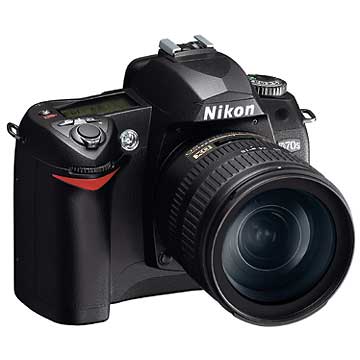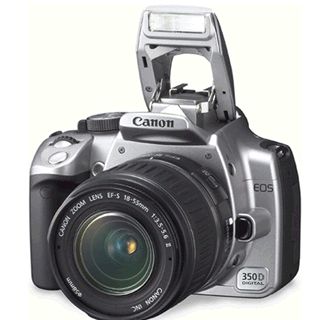To further emphasize last week’s tirade, PC Magazine usurps C|Net’s position as poster child for digital photography review incompetence. This time it is a review of the Nikon D70s, a small upgrade of my Nikon D70.
Check out this gem:
We love the D70s’ feel and design as much as we did the D70’s, and for those with larger hands, these two models may be preferable to the lighter Canon Rebel XT. The Rebel XT, however, ups the capacity ante to 8MP, which gives you the ability to print very large images, still besting the 6.1MP Nikons. The Canon kit (lens and body) is also cheaper than the D70s kit, although the Nikon lens is longer.
Let’s ignore the violation of Strunk and White Rule #1 and concentrate on the fallacious conclusions drawn from specification masturbation.
The D70s’s larger size is preferable for larger sized hands.
Obviously this conclusion is drawn from the 5″x3.7″x2.5″ (Canon) vs the 5.5″x4.4″x3.1″ (Nikon) listed dimensions. I don’t have large hands, but both these models are significantly bulkier than any digital point and shoot used by people with hands much larger than mine. The major complaint of small cameras tends to be tiny viewfinders or buttons that are easy to mispress—neither camera suffers from this. If anything, Nikon’s setup is probably a little worse in this category: the design favors right handers and the dials are both more important for shooting and more delicate. As for viewfinders, the Pentax *ist DS in the only SLR in this price range with full-sized viewfinder (it’s also smaller than both these models).
The Canon Rebel XT is lighter.
This is based on comparing 19oz (Canon) to 24oz (Nikon). I currently have any one of four lenses with my Nikon which weigh: 5.5oz (50mm f/1.8D AF Nikkor), 14.8oz (18-70mm f/3.5-4.5G ED-IF AF-S DX Zoom Nikkor), 16.07oz (12-24mm f/4G ED-IF AF-S DX Zoom Nikkor), and 48.2oz (70-200mm f/2.8G ED-IF AF-S VR Zoom-Nikkor). A general purpose kit lens accounts for half the weight of the camera and a performance zoom lens weighs twice the camera body! A dSLR’s #1 advantage comes from the ability to swap lenses. From this we see that your main pack weight and bulk in dSLR photography is a entirely dependent on lenses, not the body. This is why pro bodies are made entirely out of metal instead of polycarbonate on metal.
Digital systems like the 4/3 system from Olympus are more compact because they are designed around the smaller image sensor. Right now, that weight/selection edge favors Nikon which has six digital-specific lenses while Canon only has two.
8 megapixel gives you the ability to print very large images that 6 megapixel doesn’t.
The reviewer might as well write, “I’m a moron” with this comment. Since pixel count goes as square of the area, resolution goes as the square root of the pixel count! The actual resolution is 15% more.
Let’s put the reviewers analysis in terms of practical print images. The best prints have an effective resolution of 300dpi.1 The Nikon will make a 10 inch print at this resolution! That’s already “very large” in my book. But if it isn’t, how is 11.5 inches (Canon) “very large” and Nikon isn’t? There is more I have to bitch on this topic, but I’ve left that for another article.
The Canon kit is cheaper than the Nikon kit.
This is most specious. If the kit lens is the only one you own for a dSLR, you are better served with a ZLR bridge camera, which is easier to use and offers a wider zoom range. What we really care about is the body price. In that category, the Canon ($840) is indeed cheaper than the Nikon ($870). I leave that up to you to decide whether $30 is meaningful after you purchase lenses, tripod, tripod head, filters, and camera bags.
The Nikon lens is longer.
I think the reviewer means that the zoom range of the Nikon is 18-70mm while the Canon is 18-55mm. There are numerous comparisons you can read but it amounts to you get what you pay for.2 The price is the #1 difference between the lenses. What you get for your two extra Benjamin’s? Hint: it’s not the extra 15mm worth of magnification as the review implies.3 It is much more subtle: like an extra 2/3 of a stop when zoomed in; like metal mounts vs. plastic (may become an issue if you switch out lenses a lot); like internal focusing (since they both have wave motors, they focus fast, the practical difference here is that the Canon Kit lens has a filter mount that rotates which is a problem if you use polarizers); like ED and aspherical glass (chromatic aberration at wide angles is less with the Nikon); and amenities like a hood and a soft lens pouch.4 But did the PC Magazine reviewer mention any of these differences?
None of this really matters: Nikon will sell you a lens marginally better than Canon’s kit, and Canon has a digital lens that leaves Nikon’s kit lens in the dust.5
(The thing that I most dislike about the kit lens happens to be the non-standard (67mm) filter ring—a good set of filters will cost as much as the lens itself. You’ll notice that the reviewer overlooked that small detail.6)
Conclusion
Both cameras are great cameras with very negligible differences in performance. However, Canon and Nikon made different design choices and thus aren’t even the same camera. The Nikon is a performance dSLR (black, manual modes, flash sync, exposure + flash system, APS-C sensor) with some feature cutbacks in order to hit the lower price point (plastic body, smaller viewfinder, simpler focusing system) it has the barest nod at automatic point and shoot features (program modes). While the Canon is a point-and-shoot ZLR (bulletproof operation, silver plastic body, smaller viewfinder, simpler exposure system/flash sync) where you can swap out the lenses, have less noise (APS-C sensor), and have the ability to “go manual” in a pinch (through some menu acrobatics).
If you want to just take snapshots and swap out lenses, the Canon is a better camera. If you want to go pro later, the Nikon will not require retraining. But one camera will do as well as the other, and any is better than none.7
Someone who might buy a Nikon D70s should look at the Canon 20D and a person who might buy the Canon 350D should consider the Olympus E-300. But invoking that comparison would take cojones and half an original thought.
Instead it appears that the reviewer simply stared at the specification sheet in the classic camera war8 and regurgitated differences with sound and fury, signifying nothing. Any moron could have done that. In fact, every day in computer and electronics stores across the country, people do that every day. This is why you should buy an inferior 8 megapixel camera over a superior 6 megapixel one (unless you have “larger hands”).


Here is a DCResource review of the D70s.
Here is an article on classes to learn photography.
Why I still have warm fuzzies for Pentax (with a mention of my old Pentax Optio S).
And an article on how usability trumps specification and why we’re all guilty of a little “magical thinking†now and then.
To expound on “the best one for you is probably not a dSLRâ€:
dSLRs are bulky and hard to use. Also, people who are debating on saving a couple hundred on a “kit” are probably never going to swap out the lens anyway. If that is the case, why get a bulky, hard-to-use camera with a crappy lens in the first place?
Take the Olympus C-7070 for instance, in the review linked: “The Olympus C-7070 is quite simply one of the best semi-pro cameras available, and a real alternative to a digital SLR for the enthusiast photographer. Performance, build quality, photographic versatility and image quality are all of the very highest order. It is quite expensive, but it offers features and performance that you won’t find anywhere else for the price.â€
Samsung will develop a dSLR in alliance with Pentax. This probably means that Samsung’s camera will use a Pentax lens mount. Sony has announced that their future dSLR will use the Minolta mount.
Things are getting interesting. It looks like the odd man out is the 4-3 “standard†of Olympus. Sucks to be them.
Are you a moron? How can you liken the nikon to be a performance SLR and the canon a point and shoot!!!! What are you a self centred biased Nikon sales rep?!?!
When it comes down to it both these cameras are great budget SLRs aimed at beginners who want to dabble in a bit more control over there photography.
Ahh, a Canon zealot shows why he is a zealot. At least I admit to my zealotry and argue my point rationally. That must really stick in your craw.
Instead of reading my article as a whole, you take one statement out of context: I claimed that the design principle of the two companies comes from opposite direction to create “both great cameras with very negligible differences in performance.†You then engage in ad hominem because you feel that the truth of my argument makes you feel bad about your purchasing decision.
I have a better tactic for you. Why don’t you take more photos and blow me away with them.
Then again, that won’t work because I said that they’re both great cameras throughout my blog.
Idiot.
I reread this article I wrote expecting to take things back, but I won’t. I still think my statements about the company approaches are correct.
If they weren’t the Rebel wouldn’t have been released with crippled firmware from the 20D and it wouldn’t have been hackable in that manner.
If they weren’t there would have been a D100 sequel long before the D200.
If they weren’t the D70 would have had the single dial like in the D50 (and Canon would not have replaced their rear dial with a set of push-buttons).
If I wrote it again, I’d tame down the last paragraph where I said “just take snapshots†(I agree with the retraining issues with the Canon Rebel -> 20D upgrade, but I think the term “just take snapshots†implies something derogatory about purists. My point was I think the Nikon program modes are really limited, it seems that they really only made a token gesture in this regard.) If you go to an electronics store, they will steer you to the Canon simply based on megapixels. I know this because I pretend to be a buyer a lot just for fun at Best Buy, Frys, MicroCenter and the like. (Yes, I actually had one instance where I innocently asked what why pay more for the D70 and the “big hands†argument was regurgitated back at me.)
In fact, the only thing I want to take back is where I argue against the “small hands†thing by saying the size and weight differences are negligable. I don’t think it’s a small hands issue per-se, but the more compact layout of controls in the Canon Digital Rebel, which is evident to anyone who picks it up. Personally, I like how the Digital Rebel is so compact, though I dislike the lack of the top LCD readout—this bothers me about the Konica-Minolta Dynax series too. IMO, people who want a compact design will be attracted to the Rebel and people who prefer a more traditional design with more “heft†might like the D70 more. C|Net translates this into a “big hands/small hands†meme (probably from the days when notebook keyboards weren’t full-sized), which I still disagree with. Especially when I see it repeated everywhere.